October 12, 2007
Air Date: October 12, 2007
FULL SHOW
SEGMENTS
Nobel Peace Prize Goes Green
View the page for this story
The Intergovernmental Panel on Climate Change (IPCC) and Al Gore have won the Nobel Peace Prize for their efforts to shed light on the threat of human-induced climate change to the planet. Host Steve Curwood speaks with Harvard University Professor James McCarthy who chaired part of the third assessment of the IPCC. (07:00)
New Pesticide, Old Problems
/ Jeff YoungView the page for this story
Farmers have wanted a replacement for a pesticide that's being phased out because it destroys the planet's ozone layer. Now, EPA has approved a substitute but some leading scientists say that pesticide is highly toxic and too dangerous to use in fields. Jeff Young reports from Washington. (05:00)
Targeting Genes to Understand Behavior
/ Sheri QuinnView the page for this story
Physical attributes like hair color and skin tone can be traced to the expression of certain genes in our DNA. But, what about behavior? As reporter Sheri Quinn finds, researchers at the University of Utah may have discovered a genetic link to obsessive compulsive disorder, based on the work of this year’s Nobel Prize for Medicine winner, Dr. Mario Capecchi. (09:00)
An Earful on Corn
View the page for this story
The fate of yellow dent corn is traced from soil to supermarket in the new documentary "King Corn." Abundant, cheap, and rich in calories, the crop is found in almost everything we eat. And, as the U.S. government continues to subsidize commercial farms to drive prices down and yield up, Americans struggle with the consequences of a high-calorie, low-nutrition diet. Living on Earth’s Bruce Gellerman gets an earful from co-producer Ian Cheney about the making of the movie. (08:50)
Amazing Rare Things
View the page for this story
Naturalist and documentary film- maker Sir David Attenborough talks with host Steve Curwood about his new book, “Amazing Rare Things: The Art of Natural History in the Age of Discovery.” In the book, Sir Attenborough explores how artists exposed Europeans to nature in the New World beginning in the 15th century. (13:30)
Down the Midway
/ Emily TaylorView the page for this story
Producer Emily Taylor captures the sounds of the Rochester Fair in Rochester, New Hampshire in this audio postcard. Giant pumpkins, anyone? (02:10)
This week's EarthEar selection
listen /
download
On the beach in Wales.
Show Credits and Funders
Show Transcript
HOST: Steve Curwood
GUESTS: David Attenborough, Ian Cheney, James McCarthy
REPORTERS: Bruce Gellerman, Sheri Quinn, Emily Taylor, Jeff Young
[THEME]
CURWOOD: From Public Radio International, this is Living on Earth.
[THEME]
CURWOOD: I’m Steve Curwood. An old pesticide that destroys the planet’s protective ozone layer is being phased out. But critics say the replacement approved by the EPA could be even worse.
SCHETTLER: I’m concerned that the EPA has not used the authority that they have to require a look at the impact of this chemical on the developing brains of children before they’ve approved it.
CURWOOD: And this week Sir David Attenborough dives into the British royal art collection to show us how European artists in the Age of Enlightenment responded to their first encounters with rare species.
ATTENBOROUGH: There was a huge flood with the discovery of the New World. New creatures were being brought in all the time. And you can almost see their jaws sagging as yet another extraordinary animal is unloaded from one of the ships.
CURWOOD: We’ll have those stories and more on Living on Earth so—stick around!
[THEME]
Nobel Peace Prize Goes Green
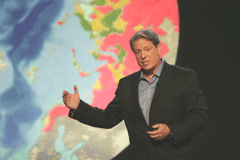
(Photo: Eric Lee, Copyright © 2006 by Paramount Classics)
CURWOOD: From the Jennifer and Ted Stanley Studios in Somerville, Massachusetts, this is Living on Earth. I’m Steve Curwood.
GORE: It’s a moral issue; it’s an ethical issue; it’s almost a spiritual issue because it affects our survival. Who are we? What is our moral responsibility to those who come after us?
CURWOOD: Former Vice President Al Gore speaking about the issue that has come to define his career—at least so far—global warming. Mr. Gore and the IPCC, the Intergovernmental Panel on Climate Change are sharing the 2007 Nobel Peace Prize for their efforts to sound the alarm about global warming. The worldwide acclaim and response to “An Inconvenient Truth,” Mr. Gore’s Oscar-wining call to arms on climate change, may well have accomplished what he could not do as Vice President.
GORE: I tried my best and I learned in the process that the opposition to the kind of dramatic changes that are needed is so deep and so ingrained that it may well be that the only way to bring about the kind of policy changes that are needed is to first of all bring about the changes in public opinion that make it possible for political leaders in both parties to do what's necessary.
CURWOOD: And change public opinion Al Gore has, as have his co-winners—the thousands of scientists of the IPCC who became an official UN body during the first Bush administration. Tufts University Professor and IPPC author Bill Moomaw:
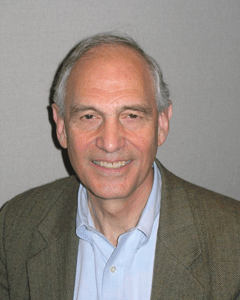
Bill Moomaw is a professor of international environmental policy at Tufts University and a lead author of several IPCC papers. (Photo: Ian Gray)
CURWOOD: But it turns out that the IPCC has become one of the strongest voices of concern. James McCarthy is a Harvard University professor who chaired part of the third IPPC assessment, and he joins me on the line. Hi, Professor.
MCCARTHY: Hello, Steve.
CURWOOD: So the IPCC, this is an organization—congratulations to you, you’ve been a part of this since 1990—what exactly does it do?
MCCARTHY: Well the IPCC brought together—for the first time in the late 80’s, and then for the fourth time just most recently this year in 2007—groups of scientists from around the world to bring the very best understanding of climate change into a single compilation that can be widely distributed and used by policy makers.
CURWOOD: And why do you think the organization has won the Nobel Peace Prize? Why is it sharing the prize for peace?
MCCARTHY: Well, who knows? It’s a very good question. I always look to the signaling of particular organizations with prizes like the Nobel Peace Prize as having had an important contribution. Those of us who have worked on this over the years certainly hope that was the case. But I think it probably is because, as this process has gone through its fourth iteration now, just recently completed its fourth assessment, it is increasingly difficult for anyone to say that there is any body of science that would refute the consensus statements of this organization: that climate change is unequivocal, the odds are nine out of ten, it’s being caused by humans, and the impacts will be widely felt on societies and on natural systems throughout the globe.
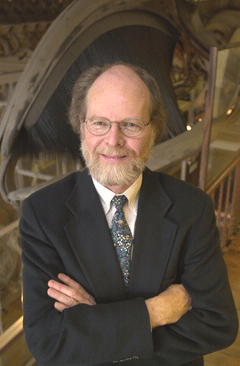
James McCarthy is the Alexander Agassiz Professor of Biological Oceanography at Harvard University and former co-chair of the IPCC's Working Group II of the Third Assessment Report. (Courtesy of Harvard Medical School)
MCCARTHY: Well I don’t know that there’s one. When it began, there really was a legitimate debate as to whether the earth was warming in an unusual way. Then when that was settled, the debate was as to whether humans had anything to do with it and if so, how much? And then the question was, well, so what? Will this really have any significant effects? And I think in each case the IPCC has brought clarity to the scientific message.
CURWOOD: At the end of the day, the peace prize has been shared by a number of institutions and persons—everyone from Martin Luther King, Wangari Maathai, the American Friends Service Committee, the International Atomic Energy Agency, and there’s often a political message here. We remember back to when the two Israeli leaders and the Egyptian leader were given the peace prize. Could this prize be a wish being expressed, a desire for some action to be taken by the part of the committee or is this a retrospective award?
MCCARTHY: It certainly, in my estimation, wouldn’t be a retrospective award because what the bodies such as the IPCC and I think, for much of his professional life, Mr. Gore have argued, is not only that we must look at the science but that we must use this information. And so far, it would be fair to say, that the world has not done a very good job of using this information. So in a sense, the peace that we would hope to come from this sort of action, which I think must be in the minds of the Nobel committee, that is to say, there is just little question, that a warmer world, is one in which there will be more conflict. There will be shortages of water, shortages of food, there will be regional strife, civil unrest.

Al Gore in "An Inconvenient Truth" (Photo: Eric Lee, Copyright © 2006 by Paramount Classics)
CURWOOD: If the Nobel committee is hoping to prompt action with this—what is the action they are hoping Mr. Gore will take upon winning this prize?
MCCARTHY: Ha ha. Well, I think to bring just higher visibility to his message and to encourage him, as he has done so successfully, to be the ambassador in political circles where few scientists have the opportunity to speak. And Mr. Gore has been a superb spokesperson for the science to influence world leaders, all nations, that we must work together and take action on this problem.
CURWOOD: Jim McCarthy was the co chair of Working Group II, the third assessment of the Intergovernmental Panel on Climate Change, winners this year of the 2007 Nobel Peace Prize, along with former vice president Al Gore. Professor McCarthy, thank you so much.
MCCARTHY: You’re welcome, Steve.
Related links:
- The Nobel Peace Prize
- To listen to a special web extra interview with Professor Bill Moomaw click here.
- "Gore Hits the Global Warming Campaign Trail" 1-19-07
- "Capitol Climate Round-up" 3-23-07
[MUSIC: Chuck Love “Long Way Down” from ‘Bring Enough To Spill Some’ (OM Records—2007)]
New Pesticide, Old Problems
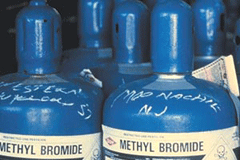
Methyl bromide (Courtesy of USDA)

Methyl bromide (Courtesy of USDA)
CURWOOD: A new controversy over an old pesticide is brewing with the U.S. Environmental Protection Agency at the center of the storm. At issue is a replacement for methyl bromide, a powerful pesticide that's being phased out because it destroys the planet's upper atmospheric layer of protective ozone. But some leading scientists say the new pesticide could pose a serious risk to public health. Living on Earth’s Jeff Young has our story.
YOUNG: Farmers who grow strawberries, tomatoes and a dozen of other crops use some 20,000 tons of methyl bromide a year. Pumped into the ground it kills insects and plant pests without leaving residue on the crops. However, when methyl bromide reaches the atmosphere it has the unfortunate habit of eating the ozone layer. So, it’s being phased out. Teresa Thorne, at Alliance for Food and Farming, an agriculture trade group, says that takes a valuable tool from farmers.
THORNE: Well it’s a big concern. Without a viable alternative, the concern is that we’re going to have very definite loss in crop yields.
YOUNG: Thorne says growers are cautiously optimistic about EPA approval this month of a possible replacement, Methyl iodide. Last year EPA decided not to approve methyl iodide because of uncertainty about the chemical’s health risks. But after further review EPA reversed that decision. Jim Gulliford leads EPA’s pesticide program.
GULLIFORD: Yes, methyl iodide is a highly toxic pesticide. So as we look then at the toxicity issues related to it, we look at the health effects, the potential for health effects—the pesticide has value from a pesticidal standpoint, it has risks. We mitigate those risks by establishing buffers, reentry times, and all of that is specifically designated for this pesticide.
YOUNG: Gulliford says methyl iodide will only be used by trained personnel. No one is allowed to enter the area where it’s applied for days. And it’s not to be used within a quarter mile of sensitive sites like schools or hospitals. But EPA’s decision drew sharp criticism in a letter from leading scientists. Dr. Ted Schettler helped write that letter. He’s a physician with the non-profit Science and Environmental Health Network. Schettler says the old pesticide, methyl bromide, injured people through accidental releases even with strict safeguards on its use. He fears accidents with methyl iodide could be worse.
SCHETTLER: Using this highly hazardous chemical in farming communities where people are living nearby is almost certain to result in unintentional exposures either to workers or to people in the community at some point.
YOUNG: Schettler says methyl iodide harms lung tissue and probably causes cancer, but that’s not his big concern. The chemical also injures the nervous system and he says developing brains of children and fetuses could be especially vulnerable. Fifty-three scientists, including six Nobel laureates, joined Schettler in the letter, calling EPA’s approval of such a hazardous chemical ‘astonishing.’ They say they are—quote—‘perplexed EPA would even consider methyl iodide for agricultural use.’ EPA’s Gulliford says he took those points into consideration.
GULLIFORD: We took a look at the letter very carefully and then I had a follow-up briefing with my people, which they indicated that they were satisfied that the issues raised by this group had been adequately addressed in the review that we had done in respect with the pesticide.
SCHETTLER: My response to that is it’s nonsense.
YOUNG: Again, Ted Schettler.
SCHETTLER: And I’m concerned that the EPA has not used the authority that they have to require a look at the impact of this chemical on the developing brains of children before they’ve approved it.
YOUNG: EPA’s Gulliford refused to address specific questions about the health concerns the scientists raised. He instead insisted that I turn off my recorder.
GULLIFORD: I’m going to end this right now. You’re asking questions that—
YOUNG: Well, okay. Let’s skip that question and move on.
GULLIFORD: No, let’s turn it off and talk about this.
YOUNG: Gulliford abruptly ended the interview when questions turned to EPA’s recent hire of an executive from the company that will make and sell methyl iodide: Arysta LifeScience. Shortly after the agency turned down the chemical last year, EPA hired Elin Miller as a regional leader. Miller had been CEO of Arysta’s North American operations. A year after her hire, EPA reversed its decision and approved methyl iodide. Miller declined to be interviewed. Arysta also decided not to comment. An Arysta press release says the company will begin sales of methyl iodide soon, in a blend of chemicals named Midas. The company must still win approval in California and Florida, the biggest U.S. markets, where growers say they need a new soil fumigant. Ted Schettler wonders if swapping one toxic chemical for another is wise.
SCHETTLER: There’s another conversation here, which gets to the wisdom of approaching this kind of agriculture by beginning the entire process through sterilizing the soil.
YOUNG: That, he says, is a conversation for another day. For now, the focus is on the EPA’s decision. And that’s something the agency will have to explain to the chair of the Senate’s Environment Committee, Barbara Boxer. She’s asked for a full briefing on why EPA said yes to methyl iodide. For Living on Earth, I’m Jeff Young in Washington.
Related links:
- To read a letter from several scientists to the EPA expressing concerns about methyl iodide, click here.
- U.S. EPA "Pesticides: Topical and Chemical Fact Sheets"
- California Strawberry Commission's fact-sheet on Methyl Bromide
- Arysta LifeScience (the company that plans to market Methyl Iodide as "Midas")
[MUSIC: Sorten Muld “The Man And The Elf Girl” from ‘Mark II’ (Northside Records—1999)]
CURWOOD: Coming up, a documentary that looks at a nation where corn is king. Keep listening to Living on Earth.
Targeting Genes to Understand Behavior
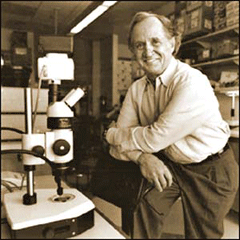
Dr. Mario Capecchi developed the revolutionary technique of gene targeting. (Courtesy of Eccles Institute of Human Genetics)
CURWOOD: It’s Living on Earth. I’m Steve Curwood. Amid the flood of this year’s Nobel Prize announcements, we noticed that Mario Capecchi was honored with the prize in medicine for his work on genetics. Dr. Capecchi was the subject of a piece by Sheri Quinn, which Living on Earth originally broadcast in 2005. We thought we’d bring it to you today to give you insight into the work the Nobel committee has decided to recognize.
The story tells of the technique called gene targeting, developed by Mario Capecchi in the late 1980s. The technique lets scientists find specific genes and change them within living mice. And as reporter Sheri Quinn discovered, this breakthrough has led researchers at the University of Utah to engineer a mouse in a way that may help us understand how genes may be tied directly to certain human behaviors.
QUINN: Christina Pearson is paying close attention to a certain group of genetically engineered mice at the University of Utah. She believes discoveries recently made there might change her life.
PEARSON: When I would pull my hair I would feel for a certain texture, I would feel for a certain sensation, a certain type of hair and then when I found the one that worked, it was if I had found gold and my nervous system would just light up.
QUINN: Pearson has trichotillomania. It's part of a spectrum that includes obsessive compulsive disorder, or OCD. Those afflicted are obsessed with pulling their hair out. But Pearson thinks this behavior is part of her inner core, locked into every cell of her body.
PEARSON: The urge to pull my hair was as strong as the urge to breathe. It felt like if I didn't pull my hair that I was suffocating. It was as if I was in a pool of water drowning, and struggling for air. I tried drinking myself into black outs because I found if I could black out and fall asleep, I wouldn't pull my hair. If we could develop an animal model it might helps us make sense and come up with treatments for human beings so they don't have to go through the 30 years of hell that I went through.
QUINN: Researchers at the University of Utah might just have such a model. But in order to understand why this work is happening here, we have to understand the work of a World War II refugee who became an American scientist. Mario Capecchi was born in Verona, Italy in 1937. When he was four, his mother was sent to the concentration camp Dachau for posting anti-fascist pamphlets. Capecchi survived by begging and stealing. Hunger, he says, helped form him.
CAPECCHI: If you are going to survive, things aren't going to work out every time. I mean, you go after a certain source of food and sometimes things don't work out and you don't get food that time and so then you have to persist and try and try again. You have to set your own inner determination—that is to be able to go after things—and that's sort of a doggedness that is important also for survival.

Dr. Mario Capecchi developed the revolutionary technique of gene targeting.(Courtesy of Eccles Institute of Human Genetics)
QUINN: Capecchi's mother was released from Dachau five years later. She searched for her now nine-year old son for over a year and found him ill with typhoid in an orphanage hospital. A few days later she brought him to the United States and Capecchi began to thrive. He grew up on a Quaker commune then went to Harvard where he eventually came to know the famous biologist James Watson, the man who together with Francis Crick had discovered the structure of DNA.
CAPECCHI: If you work in a field where lots and lots of people are working in that particular area then it does not make a big difference whether you do it or you don't do it. That science will be done. And I'd rather work on something that I feel I can uniquely contribute to.
QUINN: Capecchi taught at Harvard Medical School. But in 1973, he moved to the University of Utah. Colleagues thought he was crazy to leave Harvard. But the University of Utah had begun to build a reputation as a goldmine for human geneticists, thanks to the Church of Jesus Christ of Latter Day Saints, or Mormon Church, which keeps detailed genealogical records of its large families. At the University of Utah Capecchi spent a decade developing gene targeting. Scientists already knew how to insert altered DNA into cells. But out of thousands of cells, typically only a few will incorporate that altered DNA. The challenge was to identify which ones.
CAPECCHI: And so, if that could happen then that would allow us essentially the ability to change any gene we wanted in any way conceivable.
QUINN: Bob Horvitz is a Nobel-winning MIT biologist who is well acquainted with Capecchi's work.
HORVITZ: With Mario there is now a technology that allows the analysis of any gene in the genome. And it is the difference between night and day. No, it is much more than that. It's truly a revolution. It has led to kinds of experimentation that would have been unthinkable not very many years ago.
[SCRATCHY, SCREECHY SOUND]
QUINN: This is the sound of a tiny mouse embryo, the size of a grain of rice. Once scientists see which mouse cells have taken up the new gene, they place them into an embryo that will continue to grow into a mouse. They are called knockout mice because a gene has been knocked out and replaced. With a bit of luck, when they grow up, some of these knock out mice will transmit the new gene to their offspring.
[METAL SOUNDS]
QUINN: Capecchi's 13,000 mice are kept in a facility called the mouse house. They're cared for by a crew of biologists, former veterinary techs and pet store workers. Fred Beasley and Adine Marston often witness strange grooming behavior, and they too wonder what the research could reveal about ourselves.
FRED: Some mice like to groom themselves in interesting ways, make neat little patterns on their fur.
JUNE: Mmm Hmm. I had a cage where 11 other mice had a little rainbow shape above their left eye, every single one of them except for the one that was doing the grooming.
QUINN: Watching mice grooming. It's hard to imagine that a single gene could control such a complex behavior. But geneticist Joy Greer, a former graduate student in Capecchi's lab, replaced a normal copy of a gene called HOXB8 with a defective one. She was expecting to study limb deformities. Instead, she noticed the mice started grooming to the extreme. They stayed awake to do it. It looked to her like a form of OCD, obsessive compulsive disorder.
GREER: Oh, it was totally unexpected. Basically, I noticed that these mice had these huge bald patches and I had to find out why and while I was analyzing the video tapes it became very clear that what was happening was that the mice were removing their hair while they were grooming themselves.
QUINN: HOXB8 is a member of a large family of genes, collectively called the HOX genes, which are mostly known for their role in designing the general body plan—from flies to humans. So finding that a HOX gene could be involved in a behavior was a thrilling discovery.
GREER: And this, as far as I'm aware, is the only HOX gene that has been implicated in behavior.
QUINN: It's one thing to make comparisons between mice and humans when studying disease. But studying mouse genes to understand human behavioral disorders is new.
GREER: I think that these animals could provide a good animal model of repetitive behaviors. Whether or not it will be directly linked to obsessive compulsive disorder still remains to be seen.
QUINN: Since mice and humans have nearly identical genes, Greer and Mario Capecchi are now looking at people with the hair-pulling disorder to see if they can find the same gene defect they found in mice. It's unclear how common trichotillomania is, but it's not rare. It seems to cluster in families. Christina Pearson says most hair pullers aren't aware of it in their family history.
PEARSON: The problem with a disorder like this is that if your great grandmother had trichotillomania you probably wouldn't know it because it's still hard for people to talk about today.
QUINN: In the 1970s, when sufferers dared to seek help, doctors viewed them as psychotic. But now Christina Pearson is proud to be director of the Trichotillomania Learning Center with 32,000 hair-pulling members.
PEARSON: It is amazing the stories that I've heard. One father said to me, he said, ‘you know I was beating my daughter with a belt and she was lying there on the floor and saying, ‘Daddy, it won't help, it won't help.’ I've talked to the mothers of young women who have killed themselves, okay, put guns in their mouths because they could get no help.
QUINN: It's now been several years since Pearson has pulled her hair out. She uses medicine, therapy and group support to fight the urge.
Since the late 1980s, gene targeting has spread to thousands of laboratories throughout the world. Scientists use it to investigate the mechanisms that instruct a gene to make a limb or a wing, a hand or a paw, a behavior, even a memory. For Living on Earth, I'm Sheri Quinn in Salt Lake City, Utah.
Related link:
Dr. Mario Capecchi
[MUSIC: Gilles Peterson/Moses Dillard “Tribute to West” from ‘Gilles Peterson Digs America: Brownswood USA’ (Ubiquity Records—2005)]
An Earful on Corn
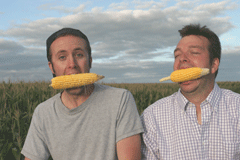
Ian Cheney (left) and Curt Ellis taste their harvest in Greene, Iowa. (Photo: Sam Cullman)
CURWOOD: Since the mid 1970s the United States has been undergoing a huge experiment. That’s when Earl Butz, then Secretary of Agriculture during the Nixon administration, announced a radical change in the nation’s farm policy.
BUTZ: What we want out of agriculture is plenty of food and that's our drive now. We have experienced a 180-degree turn in the philosophy of our farm programs. We've abandoned the long-time philosophy of curtailment and cutback to the new philosophy of expansion. And it makes sense.
CURWOOD: And lots of dollars. The policy of encouraging farmers to plant from fence line to fence line has produced bumper crops and changed the way Americans eat. In their movie “King Corn,” filmmakers Curt Ellis, Aaron Woolf and Ian Cheney chronicle the controversial change in America’s farm policy and its link to our diet. The documentary is a penetrating, at times humorous, indictment of the colossus of all crops: corn. Living on Earth’s Bruce Gellerman recently spoke with filmmaker Ian Cheney.
GELLERMAN: So how do two city guys from Boston, not far from here, come up with the idea of making a movie about corn?
CHENEY: When we graduated from college, we were confronted, one way or another, with a pretty startling realization.
GELLERMAN: You had to make a living.
CHENEY: We had to make a living. Yeah. We had to do something with ourselves. We couldn’t just keep reporting to the dorms. And the other realization was that, because of the direction of the American diet, there were a lot of studies coming out saying that our generation might actually have a shorter life span than our parents’ because of diet-related diseases, obesity, diabetes, heart disease. And—at 22—it seemed like a worthy mission to figure out, if what we’re eating is making us sick—what are we eating?
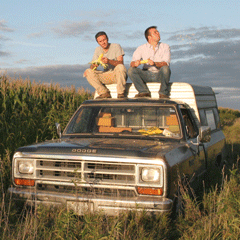
King Corn co-producers Curt Ellis and Ian Cheney perform a taste test in their acre of corn in Greene, Iowa (Photo: Sam Cullman)
CHENEY: Yeah, Steve Macko is a professor at the University of Virginia and he had been testing his students and coming up with some pretty startling results. And we sent him some of our baby hair and some of our adult hair and he noticed a difference, actually, between those two samples. He noticed that our adult hair was made out of carbon that seemed to be coming from corn. Corn—the way it photosynthesizes carbon—leaves a kind of a signature that he could trace with his maspectrometer. You are what you eat, I mean, most of my calories, growing up here in Boston, were coming from a cornfield in Iowa.
GELLERMAN: So you rent an acre of land in Iowa.
CHENEY: Mmm Hmm. We rented an acre. We didn’t even know how big an acre was. And we found a willing farmer in the town where my great grandfather grew up and my friend Curt’s great grandfather grew up. And I think he was amused that a couple of city kids were coming out to try and learn how to do agriculture.

A corn pile outside one of Iowa’s ubiquitous grain elevators. (Photo: Bryan Cheney)
CHENEY: Right. Almost all the corn you see when you drive across the country is, you know, so-called ‘field corn’ or it’s also called ‘yellow dent corn.’ And it’s really inedible. You can’t eat what you grow as a farmer in Iowa for the most part—if you’re growing corn and soy beans.
GELLERMAN: But everything you eat winds up having field corn in it.
CHENEY: Yeah. You can stroll down pretty much any aisle in the supermarket and pick up a box or a can or a tube and find an ingredient in there that, if it doesn’t say corn, it probably is made from corn—everything from multidextrin to cornstarch to high-fructose corn syrup.
GELLERMAN: In the movie, you meet a guy whose license plate is ‘CORN FED.’ And he’s on line; he’s waiting in his car to chow down at one of these fast-food restaurants. And boy, that’s quite a scene.
[SCENE FROM “CORN KING” FADES IN]
MAN: What are you eating for lunch today?
MAN 2: Corn fed beef.
MAN: Do you actually know anything about corn fed beef? Do you know what it does to ‘em? To the cattle. It’s a good thing they slaughter them when they do because it actually kills them to feed them to make the meat like that. So they’d be dead in six months anyway eating that stuff so it’s just as well that they slaughter them.
MAN 2: Really?
MAN: Yeah, it’s terrible.
MAN 2: Where is this?
MAN: Every major confinement feed lot everywhere.
[SCENE FROM “CORN KING” FADES OUT]
CHENEY: Cattle didn’t evolve to eat grains. They evolved to eat grass.
GELLERMAN: Actually, in the film you make the point that if the cattle continue to eat corn, they’ll eventually die.
CHENEY: Yeah, it makes them sick.
GELLERMAN: It’s a poison for them.
CHENEY: Yeah, we hadn’t seen anything like this in Iowa so it sparked our trip out to Colorado, east of the Rockies, to see where beef comes from.
GELLERMAN: And it comes—not from contented cows.
CHENEY: No, uh, they didn’t look that happy.
GELLERMAN: They jam these cows into these feedlots, they limit the amount of walking around they can do because that would burn calories, they stuff ‘em with corn, and then, a couple of months later, they turn ‘em into burgers.
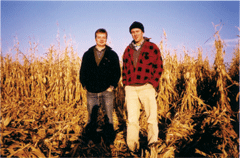
Curt Ellis (left) and Ian Cheney at their acre on harvest day. (Photo: Sam Cullman)
CHENEY: It turns your stomach to get that close to where your food comes from. And it was, I think, one of the reasons that we started out making the film is because we felt that growing up eating in the cities you’re pretty far away from where your food comes from and from the realities of it. So it’s easy to chomp a hamburger in Boston if your mind has never received an image of a big feedlot in Colorado.
GELLERMAN: You meet a guy in Brooklyn who’s a cab driver and he describes how his father has diabetes, and his mother’s got diabetes, and his sister’s got diabetes. And they’re all dying.
[SCENE FROM “CORN KING” FADES IN]
CAB DRIVER: My mom died of a direct result of diabetes. My grandmother died a direct result of diabetes. My sister Madeleine, she’s been a diabetic for years. I was recently diagnosed with diabetes. We don’t think of what we’re putting into our system. We don’t really think about it.
[SCENE FROM “CORN KING” FADES OUT]
CHENEY: There’s a lot of families like that in New York and around the country. In New York one in eight people have diabetes. It, statistically, wasn’t that improbable to hop into a cab and have your cab driver point out that his life is being ruined by diabetes. And he felt that the culprit was high-fructose corn syrup. I don’t think we will ever say, ‘type 2 diabetes is caused by corn syrup,’ but I think we can say that our diet-related diseases are related to our diet and what our diet consists of is a heck of a lot of fatty foods and a heck of a lot of sweet foods.
GELLERMAN: Ian, at the end of your movie—you had to rent the land, buy the seed, the fertilizer, machinery and all the rest of it—did you make any money off of your acre of land?

Ian Cheney (left) and Curt Ellis taste their harvest in Greene, Iowa. (Photo: Sam Cullman)
CHENEY: We didn’t make a penny off of our acre of corn. We lost money. There was so much corn grown that year that the price of corn was incredibly low. And so, even though we did a great job growing our corn—we had a real bumper crop of 177 bushels—we lost money. So we learned that that was offset, as was the case on every other Iowa farm, by government subsidies—three different government subsidies.
GELLERMAN: So if it wasn’t for these government subsidies these farmers would be losing money on every bushel they raise.
CHENEY: The farm bill for a long time has been the economy in a lot of small Iowa towns.
GELLERMAN: So if you work backwards, and you say, ‘we’re putting the farmers out of business, we’re costing the government many billions of dollars, we’re killing ourselves by eating this type of food’—maybe I’m missing something.
CHENEY: You’re not missing a thing! You’re just describing a system that is the unfortunate consequence of good intentions; trying to make food cheaper and more readily available, trying to make farmland more productive, trying to make farm work easier, and trying to help farmers make a living. Those were all the reasons we put this system in place. We’ve just taken it, maybe, too far. Perversely too far.
CURWOOD: Filmmaker Ian Cheney speaking with Living on Earth’s Bruce Gellerman. Mr. Cheney, along with Curtis Ellis and Aaron Woolf, produced the documentary film “King Corn.” It just opened in New York City and will be in theaters nationwide in November.
Related link:
"King Corn"
[MUSIC: Shannon Brown “Corn Fed” from ‘Corn Fed’ (Warner Bros. Music—2006)]
CURWOOD: Just ahead, Sir David Attenborough talks about the artist’s gaze on nature. Stay tuned to Living on Earth.
ANNOUNCER: Support for the Environmental Health desk at Living on Earth comes from the Cedar Tree Foundation. Support also comes from the Richard and Rhoda Goldman Fund for coverage of population and the environment. This is Living on Earth on PRI: Public Radio International.
Amazing Rare Things

A red-billed toucan (Ramphastos tucanus), c.1705-10 (Courtesy of the Royal Collection)
CURWOOD: It’s Living on Earth. I’m Steve Curwood. In the 15th century European explorers set out for adventure and discovery in the New World. When they returned to Europe they brought with them specimens of the odd plants and animals they found: lobsters, porcupines, and chili peppers, to mention just a few. Scientists and artists of the time were the first to document these curiosities. And over time, many of their drawings and watercolors were collected by the English kings and today are housed in the Royal Library in Windsor Castle.
That collection has recently been tapped for a book entitled “Amazing Rare Things: The Art of Natural history in the Age of Discovery.” Sir David Attenborough, who’s known for his nature documentaries, including “Planet Earth,” helped to write and edit the book. I asked him how this project got started.
ATTENBOROUGH: Well, the Royal Collection has a gallery attached to it and regularly shows things from the collection. There’s a great wealth of natural history drawings in the collection and we decided to do a selection from there. And I was invited to help in selecting the pictures and selecting the artists, which was of course an extraordinary privilege. I mean to riffle through—if I may put it that way—riffle through drawings by Leonardo da Vinci, is quite a privilege.
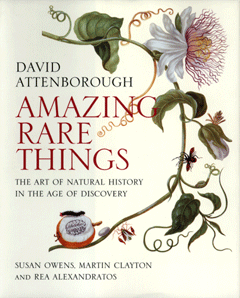
Amazing Rare Things Book cover (Courtesy of Yale University Press)
ATTENBOROUGH: Yes, I mean ‘artist’ is an inadequate word, really, for Leonardo da Vinci. I mean it’s an accurate word of course. Leonardo’s curiosity into how things worked is just mind-blowing. And the details and of course the sheer beauty of the drawings is absolutely extraordinary.
CURWOOD: Leonardo, the quintessential—perhaps the definitional—renaissance man. In your book, Sir David, you quote something that he wrote around 1490 that shows that he was even formulating a Gaia hypothesis. Could you read from that for us please?
ATTENBOROUGH: Well, Leonardo wrote: ‘Just as man is composed of earth, water, air and fire, so this body of the earth is similar. Whereas man has bones within himself, the supports and frameworks of the flesh, the world has rocks, the supports of the earth. If man has within him the lake of blood wherein the lungs expand and contract in breathing, the body of Earth has its ocean, which also expands and contracts every six hours with the breathing of the world. As from the said lake of blood arise the veins, which spread their branches through the human body. Likewise, the ocean fills the body of the earth with an infinite number of veins of water.’
CURWOOD: So indeed, a vision that the earth is an organism—the Gaia hypothesis—just like a human. And we get this from Leonardo da Vinci in 1490.
ATTENBOROUGH: That’s correct.
CURWOOD: I guess today’s environmentalists should move over for a moment.
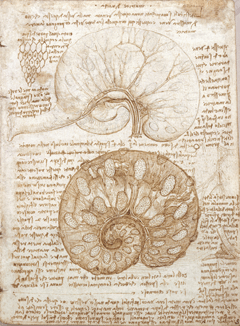
The uterus of a gravid cow, c.1508 (Courtesy of the Royal Collection)
ATTENBOROUGH: (laughs) But it’s a remarkable vision, isn’t it? And it shows such understanding of both the earth and the body.
CURWOOD: Perhaps one could say, of the people who are in your book, that they’re all at the same time artist-scientists. And perhaps that’s what, due to the time, that if you’re going to tell the story of the things you were observing that you would need to have the pictorial representation and there was no one else to do it but yourself?
ATTENBOROUGH: Yes. But some weren’t even scientists. I mean it’s quite remarkable how you actually have to know how something works before you can draw it accurately. And that’s a very interesting little problem. I mean there’s a drawing from a man called Cassiano dal Pozzo, he commissioned artists to draw these things and the artist is faced with, for example, a sloth, or maybe you call it a ‘sloth.’ But it, as you well know, it spends its life hanging upside down. Now you couldn’t possibly know that it spends its life upside down if you’d just been sent the skin, unless you really understood the mechanics of the thing. And they looked at this and they naturally drew it as if it was standing horizontally but in the normal sort of way with its feet beneath it. And the result is, I mean to our eye, of course grossly unnatural—almost comic—because it doesn’t work that way. So you really have to understand about these creatures before you can draw them accurately.
CURWOOD: One of the most interesting characters, that I’d never heard of before I’d read your book, was this woman who’d went to Suriname. Can you tell me her story, please?
ATTENBOROUGH: Yes she—Sibylla Merian was her name—she was a widow and she earned her living selling insect specimens in Holland. And in the mid 50s she decided that she’d like to go and see many of these specimens that she had been selling, and draw them in the wild. And so off she hopped, with her daughter, to Suriname. And there she collected caterpillars and watched them as they metamorphosed into the adult insects, not knowing what they were going to turn into, and produced, as a result of this, some magnificent plates which subsequently became very famous indeed, and very beautiful they are, too. You can certainly tell a Merian drawing. She has a deep affection for curls. I mean she can’t resist a curl.

A red-billed toucan (Ramphastos tucanus), c.1705-10
(Courtesy of the Royal Collection)
CURWOOD: So what was her intended audience? For these early artists of nature—who was expected to look at their works?
ATTENBOROUGH: Well, buyers. There has been always people ever since the invention of printing, who buy books for the beauty of their plates. And what more beautiful subject can you have than animals and plants? And Merian, as I said, earned her living by selling insects by insect specimens but her books became very highly treasured and very sumptuously produced too, so that she made her living by selling her books.
CURWOOD: Now in your book, only a couple of the artists that you have here ever traveled outside of Europe to go visit some of these far-flung places like Indonesia or Suriname. How did the artists get access to some of the animals and plants that they painted?
ATTENBOROUGH: They were sent back to Europe—from Roman times onward. The Romans imported animals from Africa, sometimes to slaughter in the coliseum, but sometimes because they were really strange things. In the 16th century a rhinoceros was imported into Europe, and Albrecht Durer, the great German artist, drew pictures of this, which circulated around the whole of Europe because the image of this extraordinary armored creature was so remarkable. And of course there was a huge flood from the 16th century onwards, with the discovery of the New World. New creatures being brought in all the time. And people, you can almost see their jaws sagging as yet another extraordinary animal is unloaded from one of the ships.
CURWOOD: I have to say that looking at the work of some of these early natural history artists, I see a lot of abnormal or monstrous forms of creatures or dragons, of course, or deformed pieces of fruit. What’s the appeal in seeking out these monsters of nature?
ATTENBOROUGH: Well it’s not unusual. We too think, in biology, that things that are abnormal, there is something to be learned from them. And there is also something exciting, which is something rare. I mean today people are fascinated by white tigers, for example. They think ‘my goodness, how extremely interesting they must be because of how rare they must be.’ Now biologically one knows very well that that is a very simple genetic change, which produces an albino, and these are albino animals and that albinism can be transmitted from one generation to the next. So we today still have this fascination with the rare and the odd. And of course, in a more superstitious age, a lot of people thought that these things were signs from the gods. And indeed today there are parts of the world where people will tell you that they’ve seen in a deformed root some Christian symbol or other.
CURWOOD: Sir David you’ve made a number of nature films, including, well most recently the stunning series “Planet Earth.” And thank you, so much. It’s a tremendous gift your work.

Pitch apple (Clusia rosea), c.1725 "This plant starts life as a seed scraped on to the branch of a tree by a bird or a bat. It sends down long roots to the ground, develops a large crown and eventually strangles and kills the tree on which it sits, continuing life as an independent tree standing sometimes sixty feet (18m) high. The resin from its stem is used to caulk boats."- David Attenborough (Courtesy of the Royal Collection)
CURWOOD: So tell me, to what extent do you feel that pull to the exotic, the unknown, in some of the work that you do?
ATTENBOROUGH: Oh I think all of us are drawn to seeing the unusual. I mean it’s exciting to see the unusual. And it’s very nice to think that you were the first person to see something.
CURWOOD: Tell me perhaps something you have perhaps seen for the first time. Maybe it was in a remote place. Tell me the story.
ATTENBOROUGH: Well I’m fascinated by birds of paradise; I have been since I was a kid. Don’t ask me why—well, yes, you can ask me why because I can tell you, because they’re—
CURWOOD: Why?
ATTENBOROUGH: (laughs) Thank you very much. Because they are unfailingly beautiful and extraordinary and unpredictable and in many cases unimaginable. I mean, there are 42 different species of them and they have amazing feather decorations, which the males display in courtship dances of great elaboration. And they live in a very very remote part of the world, that is to say Central New Guinea. And there are still species that have never been filmed before in performing their courtship dances
CURWOOD: Sir David before you go, could you tell us perhaps an illuminating or perhaps your most exciting travel story from all these many places you’ve visited all these years?
ATTENOROUGH: Well, 50 years of doing it, it’s difficult to choose. But let me revert to birds of paradise. There was a particular bird of paradise I was wanting to see and it displays on the ground. It’s a remarkable bird, which clears a space—an arena—on the floor of the jungle, of the rainforest, removing with great care every little tiny twig, every little bit of dead leaf until the ground is absolutely clear. And then in the early dawn it dances. The male turns up, courts the female, the females assemble and then the male performs this amazing dance displaying his plumes to the females. Most of the time, at the end of the dance the females will just look at him and just fly off and you think you can hear them saying, ‘if that’s the best you’ve got, forget it!’ But if he’s lucky, you see, he’s going to be okay.
Anyway, we spent a long time looking for this. And at the end of six weeks we found an arena and it was on the top of a ridge in a very wet part of the rainforest of western New Guinea. And we set up a hide that night and I decided that in the morning—we had two hides, one side on each side of the arena—and the cameraman was going to go into one and I was going to go into the other. And we decided that we wouldn’t take a sound recorder, I would do what I could there, but also that we would have electronic system of talking—me talking to the cameraman so that he could hear what I said and I didn’t—we were whispering. And the bird came down and it did its dance and I was just simply thrilled to the marrow. And then the bird finished and flew away and the cameraman and I scrambled down this very steep side of the ridge towards our camp. And as we came down the recordist who we’d left in the camp—the sound recordist—came out and waved and I yelled back I said ‘We’ve got it! We’ve got it!’ And the recordist said, ‘I knew the precise moment that you saw it because through that microphone, which was on your chest, the radio microphone, I could hear your heart beat. And it suddenly doubled its speed.’ And that’s the reaction which one seeks to create in view of looking at television programs of the natural world. And in many ways that’s the reaction that I’m sure these artists, who are in this book, hoped to create and those who came to look at their drawings.
CURWOOD: Sir David Attenborough’s new book is called “Amazing Rare Things: The Art of Natural History in the Age of Discovery.” Thank you so much, Sir David.
ATTENBOROUGH: It was a pleasure.
Related links:
- The Royal Collection: "Amazing Rare Things: The Art of Natural History in the Age of Discovery"
- David Attenborough's "Planet Earth"
[MUSIC: Kronos Quartet “Wawshishijay (Our Beginning)” from ‘Pieces Of Africa’ (Electra Records—1992)]
Down the Midway
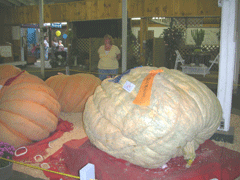
The award-winning pumpkin tipped the scales at 1,095 pounds. (Photo: Emily Taylor)
[SOUND OF HORNS, PEOPLE TALKING]
CURWOOD: Horse cart racing, pumpkin weigh-ins, and arcade games are just some of the many activities at the Rochester Fair in Rochester, New Hampshire.

Accordionist Oliver Nicholas has played at the fair for 33 years. (Photo: Emily Taylor)
[BELL RINGS, CHILDREN SHOUT]
CURWOOD: And what better way to celebrate the fall harvest then by taking a stroll along the fairground midway. Living on Earth’s Emily Taylor took her recorder and did just that. She put it all together in this audio postcard.
[ACCORDION PLAYS, MAN SHOUTS TO PASSERSBY “YOU CAN”T WIN BY WALKING BY, COME ON IN GIVE IT A TRY FOLKS . . . “]

The award-winning pumpkin tipped the scales at 1,095 pounds. (Photo: Emily Taylor)
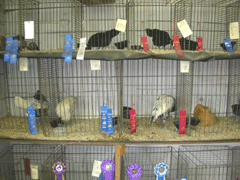
These squawkers picked up some ribbons in the poultry barn at the Rochester Fair. (Photo: Emily Taylor)
[ANIMAL NOISES, DUCK QUACKS, CHILD SAYS “WHY’S HE MAD AT US?” OTHER CHILD SAYS “HE’S NOT MAD AT US,” FAIR MUSIC PLAYS]
CURWOOD: Our audio postcard of the Rochester Fair was recorded by Emily Taylor.
Related link:
Rochester Fair
CURWOOD: Next time on Living on Earth: Geneticists are halfway through a landmark five-year study to trace our origins back to Adam and Eve. It involves testing tens of thousands of people, maybe even you.
WELLS: The big surprise, again and again and again, is that despite this incredible diversity we see around the world—the 6,000 languages and the different physical appearances and so on—we’re all incredibly closely related. We’re 99.9 percent identical at the genetic level.
CURWOOD: Mapping our genetic odyssey. Next time on Living on Earth.
[ANIMAL SOUNDS, WAVES CRASH]
CURWOOD: We leave you this week in the British wilds. On a warm October day waves crash underneath a 150-foot cliff in Dyfed, Wales. Richard Margoschis captured the sounds of the gray seal pup and bull and cow seals lying about on a small, stony beach called Martin’s Haven.
[MUSIC: Richard Margochis “Welsh Cove” from ‘Wild Britian’ (British Library Board—1997)]
CURWOOD: Living on Earth is produced by the World Media Foundation. Our crew includes Ashley Ahearn, Eileen Bolinsky, Bruce Gellerman, Ingrid Lobet, Emily Taylor, abnd Jeff Young—with help from Bobby Bascomb, and Kelley Cronin. Our interns are Alexandra Gutierrez and Mitra Taj. Jeff Turton is our technical director. Alison Lirish Dean composed our themes. You can find us at L-O-E-dot-org. I’m Steve Curwood. Thanks for listening.
ANNOUNCER: Funding for Living on Earth comes from the National Science Foundation; supporting coverage of emerging science. And Stonyfield Farm; organic yogurt and smoothies. Stonyfield pays its farmers not to use artificial growth hormones on their cows. Details at Stonyfield.com. Support also comes from you our listeners, the Ford Foundation, the Town Creek Foundation, the Oak Foundation; supporting coverage of climate change and marine issues, and Pax World Mutual Funds; socially and environmentally sustainable investing. Pax World: for tomorrow. On the web at PaxWorld.com.
ANNOUNCER 2: PRI: Public Radio International.
Living on Earth wants to hear from you!
Living on Earth
62 Calef Highway, Suite 212
Lee, NH 03861
Telephone: 617-287-4121
E-mail: comments@loe.org
Newsletter [Click here]
Donate to Living on Earth!
Living on Earth is an independent media program and relies entirely on contributions from listeners and institutions supporting public service. Please donate now to preserve an independent environmental voice.
NewsletterLiving on Earth offers a weekly delivery of the show's rundown to your mailbox. Sign up for our newsletter today!
 Sailors For The Sea: Be the change you want to sea.
Sailors For The Sea: Be the change you want to sea.
 The Grantham Foundation for the Protection of the Environment: Committed to protecting and improving the health of the global environment.
The Grantham Foundation for the Protection of the Environment: Committed to protecting and improving the health of the global environment.
 Contribute to Living on Earth and receive, as our gift to you, an archival print of one of Mark Seth Lender's extraordinary wildlife photographs. Follow the link to see Mark's current collection of photographs.
Contribute to Living on Earth and receive, as our gift to you, an archival print of one of Mark Seth Lender's extraordinary wildlife photographs. Follow the link to see Mark's current collection of photographs.
 Buy a signed copy of Mark Seth Lender's book Smeagull the Seagull & support Living on Earth
Buy a signed copy of Mark Seth Lender's book Smeagull the Seagull & support Living on Earth

